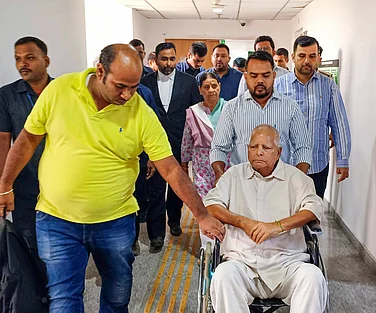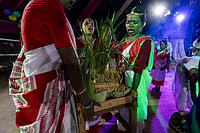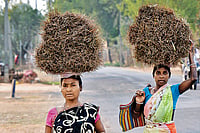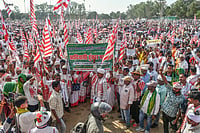Beega Tana Bhagat, 75, wears a Gandhi cap, dhoti-kurta and a Khadi jacket. On any given day, he is found at the Morabadi Maidan in Ranchi, Jharkhand. There is a statue of Mahatma Gandhi on the ground. Bhagat has taken up the responsibility of looking after the statue. That’s the purpose of his life. He never met Gandhi, but dedicated his life to spreading his message of peace and non-violence. He left his family and ancestral home in Nagri village in Bhandra block of Lohardaga in 1980, never to go back. Since 2012, he has been living in a room on the premises. His routine involves cleaning the premises and taking care of the Gandhi statue. In exchange for this, the Khadi Board gives him Rs 9,000 a month.
When asked why he worships Gandhi, Bhagat says: “Our ancestors fought with Gandhi against the British. People are slowly forgetting him. But we can never forget him.” He adds: “On October 2, more than 2,000 Tana Bhagats from across the state will visit this place. After garlanding the statue of Gandhi, they visit different villages to spread the message of Gandhi.”
Who are Tana Bhagats?
Senior journalist Arvind Mohan states in his book Champaran Diary that Gandhi met a delegation of Tana Bhagats for the first time in Ranchi on July 8, 1917, in connection with his Champaran movement. “I met the Tana Bhagat tribal group today. They are non-violent and virtuous people,” he had said then.
Ganga Tana Bhagat, 83, who had been an MLA from Mandar in Ranchi in 1984, says: “We are honest and true followers of Gandhi. When Gandhi was in prison in 1922, Tana Bhagats, too, followed him. In prison, they would spin the charkha along with Gandhi. We were a part of all the Gandhi’s movements and around 1.6 lakh Tana Bhagats participated in the Quit India movement.”
Tana Bhagats would always tread on the path prescribed by Gandhi. They stopped paying land revenue to the British. Zamindars were opposed and all things belonging to the British, their food, clothes, were boycotted. “The angry Britishers auctioned our lands. Gandhi was very impressed. He said that after independence, we would get our land back. But that has not happened,” he says.
The Baradih village in Bero block, 40 kms from Ranchi, has a considerable Tana Bhagat population. Ganga Tana Bhagat is a resident of this village and he informs that Gandhi had visited Bero and met Tana Bhagats. As per their associations, there are around 25,000 Tana Bhagats in Jharkhand. They mostly reside in Ranchi district - Mandar, Budmu, Bedo, Lapung, Lohardaga district - Kud, Kisko, Senha, and Gumla District - Ghaghra, Bishanpur, Sisai, Palkot, Chainpur, Dumri, Basia regions of Jharkhand.
Tana Bhagats belong to the Oraon tribe. Sanjay Krishna, who has been doing his research on them, says: “Born in 1888, Jatra Oroan lived in Chingari village of Bishanpur block in Gumla district. In 1914, when he was 20, he had a self-realisation while gaining knowledge of the occult. He decided to guide the tribal community, gripped in superstitious beliefs, against the atrocities of the British government and the indiscretion of the landlords.”
He adds: “The same year, he gained spiritual knowledge, too. He urged people not to worship ghosts and diverse Gods, to live simple lives, stop animal sacrifice and consumption of alcohol, cultivating on other’s land and be virtuous. His message spread, his followers increased and many people became his disciple. This is how Jatra Oraon Tana Baba came into existence.”
When he started his movement against the British and the landlords, dissuading his disciples from working as labourers, he was arrested and sent to prison by the British in 1916. He was tortured for a year and he died within two months after coming out of the prison.
Jatra and his disciples consider red as the symbol of violence. They refrain from the consumption of pigs and chickens. They do not consume food touched by others.
Auctioned lands have not been returned
Tana Bhagat, who follow the path of truth and non-violence shown by Gandhi, held a fierce agitation last year. In October 2022, they cordoned off the DC’s office at Latehar for the want of fulfillment of their demands. They sat on a dharna and locked the gate. They cordoned off the Latehar District Court complex for five hours and blocked the railway track. Taking cognigance of the matter, the Jharkhand High Court sought a report from the state's Chief Secretary and DGP. Around 40 people went to prison in connection with the case.
Paremeshwar Tana, the president of the All India Tana Bhagat Committee, says: “People who are involved in this act are not Tana Bhagat. Outsiders, who were not Tana Bhagat, had got involved in this. These people tried to tarnish the image of the Tana Bhagats. As a result, around 40 of our Tana Bhagats had been imprisoned. We have our own demands. We have been regularly visiting the district administration in this regard. We have never used violent methods to get our demands fulfilled.”
Erstwhile MLA Ganga Tana Bhagat reiterates that it was a conspiracy against the Tana Bhagats. He is of the opinion that Tana Bhagats are the disciples of Gandhi, who never resorted to violent means for India’s independence. Their people can never adopt violent methods. Last year’s incident at Latehar was carried out to defame Tana Bhagats.
A Tana Bhagat development authority has been formed for the welfare of Tana Bhagats. However, they feel nothing much has been done for them. Ganga Tana Bhagat and Parmeshwar inform that two years back, they were asked to adorn Khadi attire for which they were promised to be paid an amount of Rs 2,000 every year. But in two years, barring a few, many people have not received that money to date. The land that was auctioned by the British at the time of fighting for independence was said to be returned to Tana Bhagats, has also not been returned. Many Tana Bhagats are landless and they do not have a house to live in.
Senior journalist Krishna says: “Tana Bhagats have been fighting for their land rights after independence. There was a welfare board made for them in undivided Bihar. After the formation of Jharkhand, the government has again created a commission for them with the prime responsibility of returning their land. Some people have got their lands back. However, most of the families are still devoid of their lands, for which they continue their agitation.”
Dr Sangeeta Dasgupta, a teacher at the Centre for Historical Studies, Jawaharlal Nehru University, New Delhi and author of Reordering Adivasi Worlds: Representation, Resistance, Memory, says: “Both Jatra Bhagat and Gandhiji are babas (wise people), deities in the Tana pantheon of Gods; the Tana understanding of Gandhiji reflects the ways through which the Tana Bhagats relate to the divine world and to their everyday world.”
She adds: “Gandhiji, a historical figure and a leader of the Congress, who had led the freedom struggle and had outlined ideals that the Tanas claim to uphold even today, is elevated to the status of a baba, a maharaj, due to his allegedly extraordinary powers to deliver divine justice. Non-violence is a Gandhian ideal that the Tana Bhagats claim for themselves, which links their past with Gandhi and that of the Indian nation, on the basis of which the Tanas claim special privileges from the government and negotiate with the present.”
(Translated by Kaveri Mishra)



























